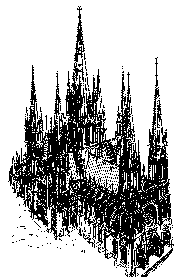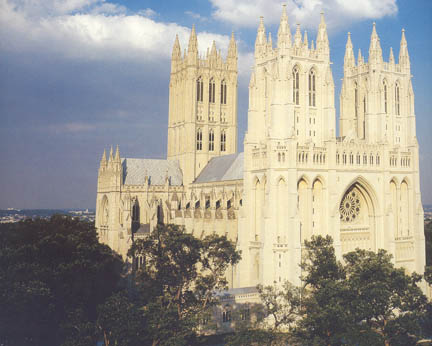
Masonic Education Series
Accepted Masons
It was no accident that the great cathedral builders of Medieval Europe worked in stone; their intent was to craft edifices that are like the Creator Himself—that endure for all time and eternity.
Masonic writers discuss Masonry from several perspectives. Some focus on operative masonry; they deal with workers in the building trades who erect physical buildings, and they take you back to the Egyptian temples and the Egyptian mysteries five thousand years ago. Operative masons have a history that goes back to the beginning of civilization. The Ancient Egyptians used stone columns and laid massive slabs of stones across to support a roof. The operative Masons of ancient time have produced wonders of architecture that continue to amaze us today.
Other writers focus on the Legend of Masonry, which includes the story of Hiram Abiff . Much of this story is found in the Bible. You will find the description of the Temple, including the grand pillars Boaz and Jachin, in the book of Second Chronicles as well as in First Kings. I refer to this as Masonic legend because some of the details of the Masonic story cannot be found in the Bible or in any other historic document, for example, the ruffians Jubela, Jubelo, and Jubelum. This group of writers occupy themselves with symbolically building King Solomon's Temple.
The third category of writers focus on Speculative Craft Masonry, which I like to think of as the modern body of Masons. This is the body of Masonry that came about since the formation of the Grand Lodge of England in 1717. They have a recent history and a fixed origin that goes no farther back than the year 1717. This group of Masons is busy building a spiritual building in which each member of the Craft is a "Living Stone."
In your research, you need to understand a writer's perspective in order to evaluate what the writer is trying to prove. For example, I have heard men in irregular bodies of Masonry say that the history of their Grand Lodge can be traced back to the building of King Solomon's Temple. When I ask them to tell me who their Grand Master was prior to the year 1910, they have no answer, and the reason is that this particular group has no actual history before that year, the year that an expelled Past Grand Master illegally formed a Grand Lodge of his own and styled it “Masonic.”
 I want to discuss Speculative Masonry, the body of Masonry that has a history going back to 1717, but I want to take you back before the year 1717 so that you can see some of the forces at work that brought Masonry as we know it in modern times into being. The Grand Lodge of England did not exist as an organized body prior to 1717, but Speculative Masons could be found in droves. It all goes back to the middle ages when the spectacular Gothic Cathedrals were being built in Europe. As far back as the Thirteenth and Fourteenth Century, the artistic skill of the cathedral builders had advanced tremendously and the cathedrals they were raising in the name of God were masterpieces of architecture. The spectacle of these buildings confounds the mind. Some of these cathedrals, built six and seven hundred years ago, still stand today and it seems almost impossible that they could have been built without the aid of backhoes, cranes, and gasoline engines. But no such conveniences had been invented when these amazing structures were raised.
I want to discuss Speculative Masonry, the body of Masonry that has a history going back to 1717, but I want to take you back before the year 1717 so that you can see some of the forces at work that brought Masonry as we know it in modern times into being. The Grand Lodge of England did not exist as an organized body prior to 1717, but Speculative Masons could be found in droves. It all goes back to the middle ages when the spectacular Gothic Cathedrals were being built in Europe. As far back as the Thirteenth and Fourteenth Century, the artistic skill of the cathedral builders had advanced tremendously and the cathedrals they were raising in the name of God were masterpieces of architecture. The spectacle of these buildings confounds the mind. Some of these cathedrals, built six and seven hundred years ago, still stand today and it seems almost impossible that they could have been built without the aid of backhoes, cranes, and gasoline engines. But no such conveniences had been invented when these amazing structures were raised.
These cathedrals were admired by a great many of the nobility and aristocracy of Europe, and some of these aristocrats wanted to learn the secrets of their construction. How did these operative Masons in these backwards times, accomplish such miracles of construction? These aristocrats had no interest in becoming stone masons, but they had a burning curiosity to learn how these miracles of architecture were accomplished. Over a period of time, the craft guilds made an important discovery: these men of leisure and men of means could be important financial backers. So the craft guilds began to accept these amateurs as members. There are records in Scotland showing that such people were admitted into the regular lodges of stone masons as honorary members; the admission of one honorary member into the Edinburgh Lodge was recorded as early as 1600. One source states that:
…By 1670 the Aberdeen Lodge consisted of 4 noblemen, 3 gentlemen, 15 tradesmen other than masons, and only 10 working masons. However, the first real landmark in the history of modern freemasonry was the foundation, by the London mason's company, of a parallel body called the "Acception" in about 1619. This organization was set up for the admission of men who were not masons by trade; they were known as "accepted Masons" or "gentlemen Masons" and they did not belong to the company proper, though they paid double the regular initiation fee, and doubtless helped to build up the funds.
It was these Accepted Masons who got together in 1717 and formed a Grand Lodge of Free Masons and Accepted Masons. And the inspiration for it all was the majesty of the beautiful Gothic Cathedrals. But that's not the entire story because something unexpected happened when these aristocrats got involved with operative craft Masons: they were exposed to a fraternal code that bound the operative masons together as a society of friends and brothers. It was this fraternal code, and the way of life that it engenders, that the Accepted Masons learned to emulate. Out of this fraternal code developed a system of morality based on the fatherhood of God and the brotherhood of man. Out of it came the basic tenets of brotherly love, relief, and truth. In my opinion, it is the effort to create and sustain this moral code more than any other aspect of Masonry, that makes the Order so great.
Lodges were established to teach this moral code. These lodges of Accepted Masons were designed to look like the craft guilds of operative masons; they had a similar organization with apprentices, fellows, and masters. And the lessons taught in these lodges of Accepted Masons were illustrated and reinforced using tools of architecture to reminds the student symbolically of the moral truths. The plumb measures uprightness and it reminds us to be upright in our actions. The level reminds us that we are all on the same plane, or that we are all equal in the sight of God. And so on, and so on. We have many symbols and a lot of symbolism. All of it is designed to help us remember some important moral or Masonic truth.
Only one material was considered suitable for the great cathedrals, and that was stone.
Only one material was considered suitable for the great cathedrals, and that was stone. Mud-bricks are used for a lot of things, but they were never used in building cathedrals, not until the Twentieth Century. But Stone Masons were not the only craft guilds involved in building a cathedral. There were mortar makers, carpenters, blacksmiths, roofers, and glassmakers, among others. The role of the mortar makers and glassmakers is obvious. Carpenters built the forms used to support the vaults and arches as they rose, they built the scaffolds, and they built the supports for the lead-sheeted roof. Blacksmiths made nails, tools, hinges, and various ornaments. But the greater volume of workers were workers in stone—the quarrymen, the master stone cutters, and the master sculptors. And the chief administrator, the person in charge of it all, was a stone mason whose title was Master Mason. He was the architect, surveyor, civil engineer, and artist who designed the plan, chose the quarry, chose the lime and all the other materials to be used in the construction; he supervised the whole building project and stayed on until the project was completed or abandoned, or until his death.
Cathedrals built today of concrete and steel do not compare to the structures raised by the stone masons of Medieval Europe. Many a stone mason devoted his life to the venture, at times traveling to foreign countries to find his next project. Some of the cathedral projects lasted a lifetime; they brought large groups of operative masons together from many foreign lands and gave them a common purpose. As a result, these workers formed special bonds of friendship and brotherly love. Building the cathedral was their livelihood, of course. They earned their wages and they moved on when money for a project was exhausted. But these men were motivated by far more than money. They engaged themselves in what was the most cutting edge technology, the most inspired artistry, and the most purposeful of all possible work in their day and time. It was not their wages that compelled them in their dangerous work, and there is one important matter that must be understood if we are to understand the full significance of these structures and if we are to understand the character of the men we seek to emulate. These cathedrals were erected to God, and it was service to God—not their wages—that sustained them.
You will never hear a Free and Accepted Mason refer to himself as a brick from which a great structures is made. Bricks are durable and solid, and they can support a structure for a lifetime, but bricks are made of mud and straw; they are made by the hand of man, and over the generations they erode. Free and Accepted Masons pattern themselves not after brick masons but stone masons: stones are raised from nature's quarries, made by the hand of God, and they are of such substance so as to endure forever. It was no accident that the great cathedral builders of Medieval Europe worked in stone; their intent was to craft edifices that are like the Creator Himself—that endure for all time and eternity.
